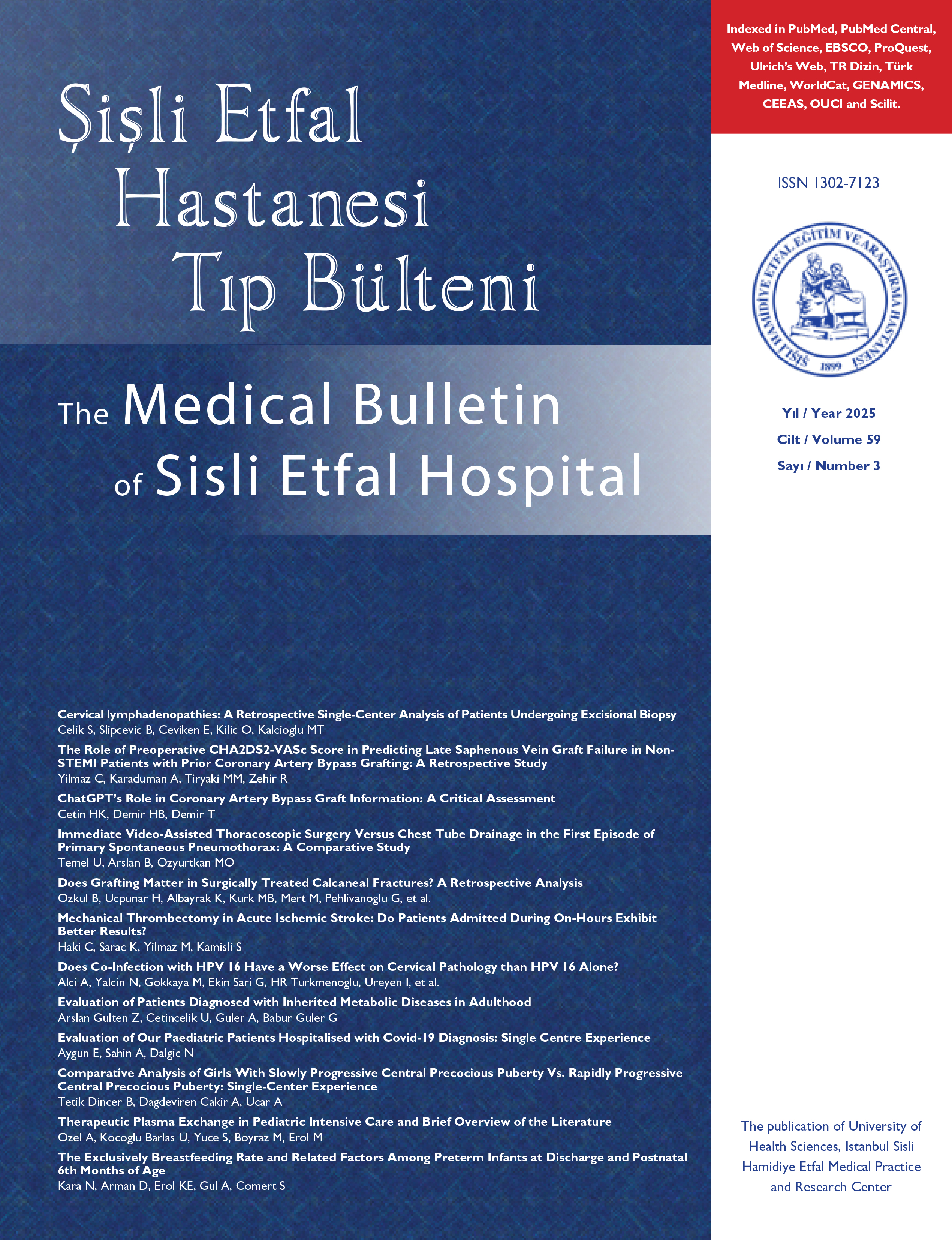
The Most Common Anatomical Variation of Recurrent Laryngeal Nerve: Extralaryngeal Branching
Mehmet Kostek, Ozan Caliskan, Ceylan Yanar, Yasin Cakir, Mehmet UludagDepartment of General Surgery, University of Health Sciences Turkey, Sisli Hamidiye Etfal Training and Research Hospital, Istanbul, TurkeyObjective: Extralaryngeal branching of recurrent laryngeal nerve (RLN) is frequent. In various studies, detection rate of extralaryngeal nerve branching was increased by intraoperative neuromonitorization (IONM). Our aim was evaluation of the relationship between the features of extralaryngeal branching of RLN and other anatomic variations in thyroidectomy patients under the guidance of IONM.
Methods: Patients underwent thyroidectomy using IONM between January 2016 and December 2019 and whose RLNs were fully explored till the nerves entry point to the larynx, were enrolled to the study. Extralaryngeal branching of RLN was accepted as branching of the nerve at a ≥5 mm distance from its laryngeal entry point and having its all branches entering the larynx. Entrapment of RLN at the region of ligament of Berry (BL) by a vascular structure or posterior BL and relationship between RLN and inferior thyroid artery (ITA) was evaluated.
Results: Out of 696 patients meeting the inclusion criteria, 1127 neck sides (536F and 160M) were evaluated. Mean age was 49.1±13.4 (range; 1889). Nerve branching ratio was 35.3% and was higher in females than males (38.2%vs.25.8%, p<0.0001, respectively). Extralaryngeal branching of RLN was detected in 398 (35.3%) out of 1127 nerves. A total of 368 (92.5%) RLNs had two, 27 (6.8%) nerves had three, and 3 (0.7%) had multiple branches. RLN crossed anterior to and between branches of ITA more frequently in branching nerves than non-branching nerves (47.7 vs. 44.4% and 12.8% vs. 7.6%, respectively) but crossed posterior to ITA less frequently in branching nerves (38.5% vs. 48%, respectively, p=0.001). Entrapment of RLN at the region of BL was higher in branched nerves (25.9% vs. 17.5%, respectively, p=0.001). Entrapment of RLN wasmore frequent at the right side than left side both in branching (31.5% vs.19.4%, respectively, p=0.008) and non-branching nerves (20.6% vs. 14.4%, respectively).
Conclusion: Extralaryngeal branching of RLN is not rare and mostly divided into two branches. Branching ratio is higher in females than males. In branching nerves, rate of crossing anterior to and between branches of ITA was higher, in non-branching nerves, rate of crossing posterior to ITA was higher. In branching nerves, possibility of entrapment of RLN at the region of BL was higher. Both in branching and non-branching nerves, entrapment of RLN at the region of BL was higher at the right side. Extralaryngeal branching, relationship between RLN and ITA, and entrapment of RLN at the region of BL are frequently seen and variable anatomic variations and cannot be foreseen preoperatively. Most of the extralaryngeal branches and their relationship with other variations can be detected by finding RLN at the level of ITA and following RLN until its entry point to the larynx.
Keywords: Intraoperative monitoring, larynx; recurrent laryngeal nerve; thyroidectomy.
Rekürren laringeal sinirin en sık anatomik varyasyonu: Ekstralaringeal dallanma
Mehmet Kostek, Ozan Caliskan, Ceylan Yanar, Yasin Cakir, Mehmet UludagSağlık Bilimleri Üniversitesi Şişli Hamidiye Etfal Eğitim ve Araştırma Hastanesi Genel Cerrahi Anabilim Dalı, İstanbulGiriş: Rekürren laringeal sinirin (RLN) ekstralaringeal dallaması sıktır. Çalışmalarda intraoperatif sinir monitörizasyonunun (İONM) ekstralaringeal sinir dallanmasının saptanma oranını arttırdığı bildirilmiştir. Biz de İONM klavuzluğunda tiroidektomi uygulanan hastalardaki ekstralaringeal dallanma özelliklerini ve diğer anatomik varyasyonlarla ilişkisini değerlendirmeyi amaçladık.
Gereç-Yöntem: Ocak 2016-Aralık 2019 tarihleri arasında İONM kılavuzluğunda tiroidektomi uygulanan ve RLN trasesinin larinkse girişine kadar ortaya koyulduğu risk altındaki sinirler çalışmaya alındı. RLNnin larinkse girmeden 5 mm ve öncesinde dallanması ekstralaringeal dallanma olarak kabul edildi. RLNnin Berry bölgesinde vasküler bir yapı veya Berry ligamanı lifleri ile posteriorundan tuzaklanması ve RLN-ITA ilişkisi değerlendirildi.
Bulgular: Yaş ortalaması 49,1±13,4 (18-89) olan 696 hastada (536K, 160E) 1127 boyun tarafı değerlendirildi. Sinir dallanması oranı %35.3 olup, kadınlarda erkeklerden daha yüksekti (sırasıyla %38.2% ve %25.8, p<0.0001). Ekstralaringeal dallanan 398 sinirin 368i (%92.5) 2 dal, 27si (%6.8) 3 dal, 3ü (%0.7) 4 daldı. RLNnin ITAyı anterior ve dallar arasından çaprazlama oranları dallanmamış sinirlere göre daha yüksek (sırası ile %47.7 ve %44.4, %12.8 ve %7.6), posteriorundan çaprazlaması (sırası ile %38.5 ve %48) daha düşüktü (p=0.001). RLNnin Berry bölgesinde tuzaklanması dallanmış sinirlerde daha yüksekti (%25.9 vs %17.5; p=0.001). Berry tuzaklaması sağ tarafta sola göre hem dallanmış sinirlerde (%31.5 ve %19.4, p=0.008) hem dallanmamış (nonbranching) sinirlerde (%20.6 ve %14.4) daha yüksekti.
Sonuç: RLNnin ekstralaringeal dallanması nadir olmayıp, genellikle 2 daldır. Kadınlarda dallanma oranı erkeklerden daha fazladır. Dallanmış sinirlerde ITA anteriorundan ve dallar arasından geçme oranı daha yüksek, dallanmamış sinirlerde ise posteriordan seyir daha sıktır. Dallanmış sinirlerde Berry bölgesinde sinirin tuzaklanma olasılığı daha yüksektir. Hem dallanmış, hem de dallanmamış sinirlerde sağ tarafta Berry bölgesinde tuzaklama daha fazladır. Ekstralaringeal dallanma, RLN arter ilişkisi ve Berry bölgesinde tuzaklanma sık görülen ve değişken olabilen anatomik varyasyonlar olup preoperatif öngörülemez. RLNnin ITA düzeyinde bulunup larinks girişine kadar takip edilmesi ile ekstralaringeal dalların büyük bölümü ve diğer anatomik varyasyonlarla ilişkisi saptanabilir. (SETB-2021-05-155)
Anahtar Kelimeler: Rekürren Laringeal Sinir, Tiroidektomi, Larinks, intraoperatif monitörizasyon
Manuscript Language: English



















